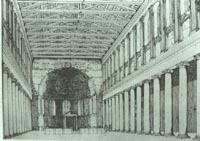
|

|
Scholars have characterized the period of Pope Sixtus III as the Sixtine Renaissance. This period is noted for a retrospective attitude where the architecture and the art consciously looks back to classical forms. One of the major monuments of this period is the Roman Church of Santa Maria Maggiore. A reconstruction of the interior of the church demonstrates the borrowing of earlier classical forms. Compare the interior of Sta. Maria Maggiore to Sta. Sabina:

|

|
Then compare the interior of Sta. Maria Maggiore to view of a reconstruction of the interior of the Baslica Ulpia which was part of the Forum of Trajan:

|
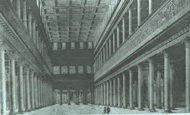
|
Sta. Maria Maggiore is particularly significant for the preservation of some of its original mosaics. The triumphal arch marking the entrance to the apse includes New Testament stories focusing on the Incarnation of Christ. Mosaic panels beneath the clerestory windows in the nave are dedicated to Old Testament stories. These mosaics are laid out as a narrative, beginning on the left hand wall adjacent to the apse with the story of Abraham. This is followed on the left or north wall with scenes from the stories of Isaac and Jacob. The story is picked up again on the right (south) wall again adjacent to the sanctuary with the stories of Moses and Joshua. The choice of subject matter is significant. Traditional Old Testament scenes like the story of Creation are omitted. Instead the focus is on a series of Old Testament heroes or leaders beginning with Abraham, the first patriarch and culminating in the Exodus narrative of Moses and Joshua leading the Israelites to the Promissed Land. This epic story of the Old Testament should be seen in relationship to the Christian plan of history of how there is a manifest destiny of the Old Testament story of the Chosen People leading to the New Testament story of Christ and culminating in the destiny of the Church and the Empire to continue this story of the Chosen People until the end of time. The Emperor saw himself as the new Augustus at the same time as the new Abraham or Moses.
The conception of this narrative thus again brings out the merging of the Roman Imperial and Christian traditions [for more of a discussion on the conventions of Roman Imperial Iconography see the page entitled Panel Reliefs of Marcus Aurelius and Roman Imperial Iconography]. This point is made even more emphatically by looking at individual scenes and seeing how the artists formulated the narrative. A good example is the story of Joshua at the Battle of Jericho where the Ark of the Covenant is being carried around the walls of Jericho:
Note especially the representation of Joshua who is just to the right of the ark on the lower register of the mosaic panel. Scholars have long noted the parallels between the narrative style of these mosaics and that found Roman Imperial art. An excellent comparison can be made to the reliefs of the Column of Trajan from the early second century A.D.:
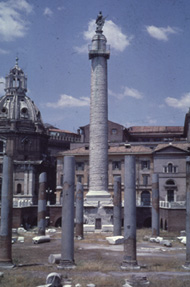
|
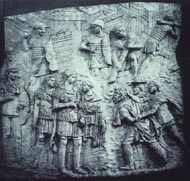
|
Joshua as the heroic leader of the Israelites is clearly parallel to Trajan as the leader of the Roman army over the "Barbarian" Dacians.
The Santa Maria Maggiore mosaics have been convincingly parallel to the miniatures in the so-called Vatican Virgil. This manuscript in the Vatican Library comes from the end of the fourth or early fifth century. Along with the Georgics, the codex contains a copy of Virgil's Aeneid, the major Roman epic poet. A miniature showing Aeneas overseeing the building of the city of Carthage clearly demonstrates the parallels to the Santa Maria Maggiore mosaics:

Aeneas as the legendary founder of the Roman tradition is clearly depicted with the same formulas associated with Roman imperial art.
The so-called Quedlinburg Itala fragment further brings out the parallels:
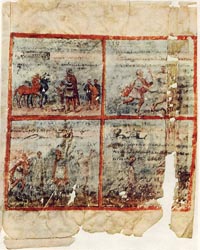
This fragment of a larger codex containing the so-called Itala edition of the Bible were found in the binding of a book in the German town of Quedlinburg. The miniatures on this page represent episodes from the 1 Book of Samuel (or 1 Kings) 15. The miniature at the upper left illustrates Saul offering a holocaust (verse 12):
See how Saul is visualized as a Roman Emperor making a sacrifice. The chariot and apparently Triumphal Arch in the back left background reinforce the triumphal imagery of the scene.
Returning to the Santa Maria Maggiore mosaics, analysis of an individual mosaic shows how the planners have used the Roman Imperial iconography along with the Christian typological reading of the Bible to make a statement of the authority of the church:
|
Marcus Aurelius as Conqueror showing his Clemency, relief from the Conservatori Museum in Rome, c. 176-180 AD. |
Melchisidek offering bread and wine to Abraham from the nave mosaics of Santa Maria Maggiore. |